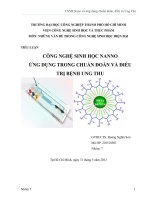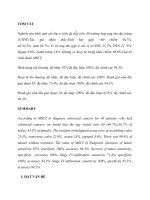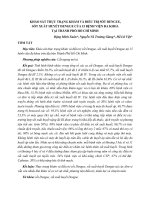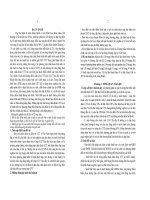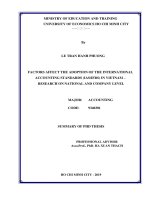Nghiên cứu giá trị sinh thiết hạch cửa trong bệnh ung thư tuyến giáp tt tiếng anh
Bạn đang xem bản rút gọn của tài liệu. Xem và tải ngay bản đầy đủ của tài liệu tại đây (551.43 KB, 27 trang )
MINISTRY OF EDUCATION MINISTRY OF HEALTH
HANOI MEDICAL UNIVERSITY
NGUYEN XUAN HAU
RESEARCH THE VALUE OF SENTINEL LYMPH
NODE BIOPSY IN THYROID CARCINOMA
Specialization :Oncology
Code
: 62720149
SUMMARY OF DOCTORAL DISSERTATION
HANOI - 2019
THIS STUDY WAS COMPLETED IN:
HANOI MEDICAL UNIVERSITY
Spervisor: Assoc. Prof. MD. Le Van Quang
Reviewer 1:Assoc. Prof. MD. Le Ngoc Ha
Reviewer 2:Assoc. Prof. MD. Ngo Thanh Tung
Reviewer 3:Assoc. Prof. MD. Le Trung Tho
The thesis will be defended before the Examining Board at
university level in Hanoi Medical University
At …….. o’clock……… Date ……. Month ……. Year…
This thesis could be found at
- National Library
- Centre Medical Information Library
LIST OF PUBLICATION RELATED TO THE
DISSERTATION
1. Nguyen Xuan Hau, Tran Thi Hau, Le Thi Hang
(2017). Clinical, subclinical characteristics and
histopathology of early thyroid cancer at Hanoi
Medical University Hospital. Vietnam Medical
Journal, Number 1, volume 456.
2. Nguyen Xuan Hau, Le Van Quang, Duong Chi
Thanh (2017). The result of visualization of sentinel
lymph node biopsy with Methylene Blue in thyroid
carcinoma. Vietnam Medical Journal, Number 2,
volume 456.
3. Nguyen Xuan Hau and Le Van Quang (2018). The
role of sentinel lymph node biopsy in thyroid
carcinoma and the factors affecting the value of the
method. Vietnam Medical Journal, Number 2,
volume 472.
4. Le Van Quang, Nguyen Van Hieu, Nguyen Xuan
Hau, Nguyen Van Hung (2018). Role of sentinel
lymph node biopsy in papillary thyroid carcinoma
in Vietnam. International Journal of Hematology
and Oncology, number 4, Volume 28.
1
INTRODUCTION
1. Reason to choose the thesis.
Thyroid cancer is the most common disease in endocrine cancer,
accounting for 3.6% of all cancers in general.
Surgery is the most important treatment in thyroid cancer.
Thyroidectomy plus lymphadenectomy increase the rate of
complications after surgery, but the disease recurrent mainly in
cervical lymph node and lymphadenectomy is the first priority
choice. Surgery to remove central lymph node in recurrent thyroid
cancer increase the risk of complications such as paralysis of the
recurrent laryngeal nerve and hypoparathyroidism. To limit systemic
cervical lymph node dissection, finding a method to detect occult
lymph node metastasis is necessary to determine the treatment
strategy. Sentinel lymph node is defined as the first lymph node in
the lymphatic drainage area to be drained from the primary tumor,
which reflects the condition of the remaining lymph nodes with or
without lymph node. This result contributes to the detection of
metastatic lymph nodes that are smaller than 2-3 mm in diameter difficult to detect by other techniques such as high resolution
ultrasound. In the world, there have been many studies on the
sentinel lymph node of thyroid cancer, however, there has not been
any research in this field in Vietnam. Therefore, we carried out the
thesis: "Research on the value of sentinel lymph node biopsy in
thyroid cancer" with the following two objectives:
1. Comment on the results of the method of visualization and sentinel
lymph node biopsy in thyroid carcinoma by Methylene blue in Hanoi
Medical University Hospital from 11/2014 to 9/2018 and analyze the
some factors affecting the results of method.
2. Evaluate the value of sentinel lymph node biopsy in the diagnosis of
occult cervical lymph node metastasis.
2. New finding of the thesis:
- This is the first study in Vietnam, using Methylene Blue to detect
sentinel lymph node in thyroid cancer, to help determine the exact
occult lymph node metastasis, thereby giving a strategy the cervical
2
lymph node dissection with the same time
reasonable
thyroidectomy.
- The rate of sentinel lymph node detection with Methylene Blue is
very high: 98.2%; Most lymph nodes are in the pre-tracheal group
(group 6): 90.4%.
- Percentage of non-metastatic lymph nodes on pathology: 55.7%;
metastasis on pathology: 44.3%, the rate of occult cervical lymph
node metastasis is very high: 51.5%.
- Sensitivity, specificity, positive predictive value, negative
predictive value, overall accuracy and false negative rate of the
method are: 86%, 100%, 100%, 87,1%, 92.8% and 14% respectively.
3. The structure of the thesis:
The thesis conclude 122 pages, with 4 main chapters: Introduction
2 pages, Chapter 1 (Overview) 40 pages, Chapter 2 (Subjects and
Research Methods) 18 pages, Chapter 3 (Research results) 29 pages ,
Chapter 4 (Discussion) 30 pages, Conclusion and Recommendations
3 pages. The thesis has 33 tables, 7 pictures and 5 charts, 155
references (26 Vietnamese references, 129 English references).
Chapter 1: OVERVIEW
1.1. Introduction
Sentinel lymph node is defined as the first lymph node in the
lymph nodes receiving lymph nodes from primary tumors. Since the
past 19 years, approved sentinel lymph node biopsy is a technique to
determine the metastatic presence of melanoma cancer and early
breast cancer. Recently, sentinel lymph node biopsy has been
proposed for use in other cancers, including thyroid cancer. The role
of this method is being clarified by the authors. The results of lymph
node biopsy help the surgeon make a decision right away in terms of
regional lymphadenopathy and appropriate management or systemic
behavior.
1.2. Sentinel lymph node biopsy in thyroid carcinoma.
1.2.1. Technology
3
Blue dye is an injection used most often with methylene blue,
isosulphan blue. This method involves injecting a blue indicator into
sites with the same lymphatic drainage system with the tumor then a
certain period of time will be performed to detect lymph nodes by
direct observation of the pathways. Blue lymphatic drainage leads to
lymph node. All blue dyes disappear during the process of making
the specimen and do not affect histological analysis.
About radioisotopes, different forms of 99m-Technetium. The
lymph nodes in these cases are detected by skin markers for lymph
nodes or it can be detected by radioactive signals using a gamma
probe during surgery.
After exposition of the thyroid gland, four quadrants around the
tumor were injected with a total of 1ml of methylene blue with
tuberculosis syringe. At this time, stop the operation for one minute
to allow diffused dye. The lymphatic pathways catch a blue stain (the
stain of the blue dye, then continue into the central cavity and the
blue stain nodes are taken and sent to frozen section.
1.2.2. Factors affecting the results of the method.
Although the studies have shown that the rate of visualization of
the sentinel lymph node with Methylene blue is very high, there is
still a small proportion of not showing the lymph nodes when
perform the method.
To explain the absence of this sentinel lymph node, many studies
suggest that the lymph node system from the tumor to the lymph
node is disrupt during the process of thyroid disclosure, the
lymphatic pathway is blocked by invasive tumors or The main
lymphatic vessels that were not detected after injecting the color
indicator may be that it is behind the esophagus or after the thyroid
site.
When studying other factors affecting the results of sentinel
lymph node such as age, sex, tumor position in lobe, tumor size,
tumor stage, multifocality, all studies showed that there was no the
relationship between the above factors with the result of the sentinel
lymph node.
4
Chapter 2: OBJECTIVES AND METHODOLOGY
2.1. Research subjects
The patient was diagnosed with thyroid cancer and surgery at the
Oncology-Palliative Care Department, Hanoi Medical University
Hospital from November 2014 to September 2018.
2.1.1. Sample size
Sample size is determined by the formula:
p(1 – p)
n = Z21-α/2
(pε)2
Where
n: Minimum sample size in the study
Z1-α/2: coefficient of confidence with a probability of 95% ( ε=
0.05) → Z = 1.96.
Select ε: deviation of p, limit of 10% (ε = 0.1)
p: percentage of lymph nodes without metastasis (p = 0.7)
according to Cabrera's study (2014)
From the above formula, we selected 170 patients
2.1.2. Criteria for selecting research subjects
- Patients diagnosed with thyroid cancer based on clinical, ultrasound
and cytology. Cases of unknown cancer in cytology and / or
ultrasound will be frozen section in surgery.
- Diagnosis of clinical stage T1,2,3,4; N0; M0 classified by AJCC
2010.
- Injection of methylene blue around the tumor.
- Surgical removal of selective lymph nodes group VI and group II,
III, VI on both sides.
- Results of postoperative pathology are differentiated thyroid
carcinoma
2.1.3. Exclusion criteria
- Metastatic lymphoma of the lymph nodes clearly clinical, distant
metastasis.
5
- There is a history of allergy to Methylene blue.
- Thyrois cancer is not the epithelial cell type.
- Patient was undergoing thyroid surgery at the other hospital.
- Patients disagree to participate in the study.
2.2. Research Methods
2.2.1. Research design
Descriptive research study
2.2.2. Research Methods
2.2.2.1. Exploiting clinical and subclinical information.
2.2.2.2.Technical process of visualization and sentinel lymph node
biopsy.
In this study, we used the method of sentinel lymph node biopsy with
Methylene Blue.
- The patient is in the supine position, his hands pressed close to his body,
neck up to the maximum, pillows placed under the shoulders to increase
the ability of the neck.
- Endotracheal anesthesia, antiseptic neck area down through depressions,
above the chin.
- Incision skin across the lower neckline, about two fingers away from the
noch of breastbone, cutting the platisma muscle, dissection the two skin
flaps up and down. Open along the neck fascia before the trachea, clearly
showing the thyroid lobe containing the tumor.
- Find and protection the parathyroid glands and recurrent laryngeal
nerves before injecting Methylene Blue, avoiding difficulties in finding
later.
- Inject 1 ml of Methylene Blue into 4 positions around the tumor: 3
hours, 6 hours, 9 hours and 12 hours. Be careful not to let Methylen
around the operation space to avoid confusion when making a judgment.
If gauze and gloves are slotted with a color indicator, they must be
replaced to avoid penetrating the surrounding organization.
- Gently massage the thyroid lobe that is injected within 1 minute with the
fingertip. Dissection around the thyroid lobe to detect blue lymphatic
drainage. This process should be carried out gently, meticulously,
hemostatic to facilitate maximum observation. Follow all the detected
6
lymphatic pathways to the stain lymph nodes (lymph nodes). Take all the
stain lymph nodes and record the sentinel lymph node in separate
groups.
- Duration is 10 - 15 minutes from the injection of color indicator. Past
that time, if the lymphatic or lymphatic channels are not detected, the
procedure is classified as not recognizing the lymph node.
- Total thyroidectomy and neck lymphadenectomy selected at the center
neck group and lateral neck group or lobe thyroidectomy plus
isthmusectomy and combined with selective neck lymph nodes remove
are conducted according to modern surgical standards for thyroid cancer.
2.2.2.3. Evaluation parameters
Sentinel lymph node biopsy
result
Frozen
Metastasis
section
No metastasis
Total
Final pahtology
Metastasis
No metastasis
a
b
Total
a+b
c
d
c+d
a+c
b+d
a+b+ c+d
- Detection rate = Number of detected cases with sentinel lymph node /
total number of cases performed
- Sensitivity = Number of sentinel lymph node (+) / Number of patients
with lymph node metastasis on final pathology= a / (a + c).
- Specificity = Number of sentinel lymph node (-) / Number of patients
with no lymph node metastasis on final pathology = d / (b + d).
- Total accuracy = (frozen section positive positive lymph node + true
negative frozen secton) / Number of lymph nodes detected = (a + d) / (a +
b + c + d).
- The rate of false negative = Number of sentinel lymph node (-) / Number
of patients with lymph node metastasis on final pathology = c / (a + c).
2.3. Data analysis
Data were collected and statistically processed with SPSS 16.0
software. according to research criteria.
The statistical method used includes:
- Descriptive statistics: average, standard deviation.
- Comparison of the ratio: test χ2, statistical significance level was
established when P <0.05 or Fisher’s exact test.
7
- Univariate evaluation method, Logistic multivariate regression
model.
Chapter 3: RESEARCH RESULT
3.1. Results of the method of visualization the sentinel lymph
node biopsy with methylene blue in thyroid cancer and factors
affecting the results of the method
3.1.1. Patient characteristics
Age: Average age: 40.3 ± 10.64 (20 - 68) years old.
Gender: The disease is mainly seen in women, the rate of women
/ men: 7.5 / 1
Clinical tumor characteristics: The percentage of tumor
palpation on clinical examination is highest, accounting for over
60%. Most patients have tumors in a thyroid lobe, accounting for
nearly 90%. The majority of tumors have a firm density, accounting
for 81.9%, and mobility is easily accounted for over 95%.
Results of thyroid ultrasound:
- The position of tumors in one of the most common lobes
accounts for nearly 90%, evenly distributed in both right and left
lobes. About 4% of the tumors are located in the isthmus and 7% are
in both lobes. In the lobe, tumors in the most common middle third
account for over 55%. On ultrasound, hypoechoic is the most
common accounts for over 80%, microcalcifiation accounts for
54.1%, angiogenesis accounts for 34.7%, unknown boundaries
account for only over 25%.
- Most patients are classified TIRADS 4-5 on ultrasound,
accounting for more than 98%. Among them, the most common
TIRADS 4b accounts for more than 40%. However, 1.2% of thyroid
cancer on ultrasound is TIRADS 3 image.
- Most patients on ultrasound have only 1 tumor accounting for
over 77%, 22.4% of patients have more than 1 tumor on ultrasound,
of which 7% have 3 tumors.
- Most patients have tumor size <2 cm, accounting for 88.8%,
tumor size> 4 cm accounts for only 1.2%.
Cytology: 100% of patients were performed fine needle
aspiration before surgery. The results of cytology diagnosed with
8
cancer or suspected of cancer account for 93%. only about 7% of
thyroid cacner but benign cytology results.
Frozen section: More than 85% of patients have the frozen
section tumor intraopetatively, 100% of results are cancer.
Procedure of thyroid surgery: The patient had total
thyroidectomy, accounting for 89.4%, lobe thyroidectomy plus
isthmusectomy accounted for 10.6%.
Pathology result of thyroid tumors: Papillary adenocarcinoma
accounts for the majority of cases over 99%. Follicular carcinoma
accounted for only 0.7%.
Thyroid inflammation enclosed: Among patients with thyroid
cancer, more than 11% of patients had thyroiditis with cancer.
T stage: Clinically, the majority of patients diagnosed with T1 stage
account for about 90%. However, on pathlogy, the proportion of T1
patients accounted for only over 52%, the rate of T3 stage tumors
increased to 37.6%.
3.1.2. The results of the method of visualization the sentinel lymph
nodes biopsy by methylene blue and the factors affecting the results
of the method
The rate of detection of sentinel lymph nodes with methylene blue:
The rate of detection of sentinel lymph nodes with methylene blue is
very high, accounting for 98.2%.
Some factors affecting the result of sentinel lymph node.
Table 3.1. Some factors affecting the result of the method
Factor
SLN (+)
(n=167)
SLN(-)
(n=3)
%
109
2
98,2
58
1
98,3
OR
95% CI
p
1,06
0,094 – 12
1
Age
<45
≥45
9
Tumor positon
on the lobe
(n=163)*
1/3 uper
23
1
95,8
1/3 midle
91
0
100
1/3 lower
46
2
95,8
<1cm
84
1
98,8
≥1cm
83
2
97,6
Gender
Male
19
1
95,0
Female
148
2
98,2
T stage
T1,2
98
3
97
T3,4
69
0
100
number
unifocal
131
1
99,2
Multifocal
36
2
94,7
--
--
0,145
0,5
0,04 – 5,6
1
3,9
0,33-45
0,32
--
--
0,27
7,3
0,64 – 82,6
0,13
Tumor size
* 7 tumors on the isthmus cases; SLN: sentinel lymph node
Comment: The percentage of sentinel lymph node result of the
position of the middle third tumor has a 100% compared to the group
of patients with tumor position in uper third of 95.8% and lower third
95.8 %, this difference is not statistically significant p = 0.145. The
patients at T1 and T2 stage had a lower incidence of sentinel lymph
node than patients in the T3 and T4 stage (97% versus 100%), this
difference was not statistically significant. p= 0.27.
The number of sentinel lymph nodes detected: The average number
of sentinel lymph nodes 3.4 ± 1.99; The maximum number of nodes
is 12, at least 1. Most patients detected more than 1 lymph node
accounted for more than 85%.
The position of the lymph node: Sentinel lymph node detected in the
pretracheal group (group 6) is the most common, accounting for
10
more than 90% (150/167). There were 6.0% (11/167) patients with
sentinel lymph nodes found in the both pretraheal and lateral group,
while the percentage of sentinel lymph nodes detected in the
ipsilateral group: 3.6% (6/167).
The position of the sentinel lymph node in the pretracheal group:
In the pretracheal group, the highest percentage of sentinel lymph
node was detected in the recurrent chain group above 85%. The rate
of detection of sentinel lymph node in the group pretracheal is only
about 5%, prelaryngeal (Denphien lymph nodes) only accounts for
about 1%. There were 3.7% of sentinel lymph node detected in both
groups of the recurrent chain group and the prelaryneal.
The number of cervical lymph nodes: The average number of
cervical lymph nodes were 21,89 ± 9.09 nodes, the highest is 64
nodes, at least 4 nodes.
3.2. The value of sentinel lymph node biopsy in diagnosis of
cervical lymph node metastasis
3.2.1. Status of sentinel lymph node metastasis on frozen section
Table 3.2. sentinel lymph node metastasis status on frozen section
Sentinel lymph node
Patients (n)
Rate %
metastasis
66
39,5
No metastasis
101
60,5
Total
167
100
Comments: In 167 patients with senetinel lymph node detected by
methylene blue, all these lymph nodes were sent to prozen section.
The rate of SLN metastasis accounts for 39.5%, 60.5% of the SLN
negative on frozen section.
3.2.2. Status of sentinel lymph node metastasis on pathology
11
Table 3.3. sentinel lymph node metastasis status on pathology
Sentinel lymph node
Patients (n)
Rate %
metastasis
74
44,3
No metastasis
93
55,7
Total
167
100
Comment: On pathology, the number of patients with SLN
metastasis accounting for more than 44%, the percentage of negative
SLN on routine pathology was 55.7%.
3.2.3. The number of metastatic SLN on final pathology
The average number of SLN metastasis: 1.97 ± 1.05 nodes. In 74
cases of SLN on pathology: the average number of SLN metastatic
were 1.97 ± 1.05, at most 5 metastases, at least 1 lymph node.
3.2.4. Relation between the SLN on frozen section and the
pathology
All lymph nodes after frozen section are sent for final pathology.
Of the 74 patients with SLN metastasis on pathology, 8 patients with
frozen section results were negative. The rate of false negative were
10.8% (8/74).
3.2.5. Results of cervical lymph node pathology: The rate of cervical
lymph node metastasis in the study group was 51.5%
3.2.6. Relationship between the SLN results on pathology and
cervical lymph node result.
Table 3.4. Relationship between the SLN results on pathology and
cervical lymph node result.
SLN on
pathology
Cervical lymh node
Total
metastasis
No metastasis
metastasis
74
0
No metastasis
12
81
93
Total
86
81
167
74
12
Sensitivity = 74 / (74 + 12) = 86%
Specificity = 81 / (81 + 0) = 100%
Positive predictive value = 74 / (74 + 0) = 100%
Negative predictive value = 81 / (81 + 12) = 87.1%
Total accuracy = (74 + 81) / (74 + 0 + 12 + 81) = 92.8%
False negative rate = 12 / (12 + 74) = 14%
3.2.7. The relationship between SLN metastasis on frozen section
and the some factors
Table 3.5. The relationship between SLN metastasis on frozen
section and the some factors
SLN metastasis
Factor
Yes
No
<45
52
57
≥45
14
44
Male
11
8
Female
55
93
T1-2
31
67
T3-4
35
34
<1cm
27
57
≥1cm
39
44
9
27
Unifocal
57
74
TSH
Anormal
2
10
concentration
Normal
64
91
Papillary
64
93
Follicular variant
1
8
Follicular
1
0
Yes
5
15
No
61
86
Age
Gender
T stage
Tumor size
Tumor number Multifocal
Pathology
subtype.
Thyroiditis
OR 95% CI
p
2,87
1,4-5,8
0,03
2,3
0,88-6,1 0,08
0,45 0,24-0,85 0,01
0,5
0,3-1,0
0,05
0,4
0,2-0,99 0,04
0,13 0,06-1,34 0,13
--
--
0,1
0,15 0,16-1,4 0,15
13
Comment: There was the relationship between SLN metastasis on
frozen section with factors: age, stage T, and tumor number (p: 0.03,
0.01 and 0.04 respectively).
When multivariate analysis of SLN metastasis on frozen section
and some factors: patients <45 years of age had a risk of SLN
metastasis on frozen section 2.9 times higher than patients ≥ 45 years
old (95% CI : 1.33 - 6.44, p = 0.008). Patients in T1.2 stage reduced
the risk of SLN metastasis on frozen section 1 / 0.39 = 2.56 times
(95% CI: 0.2 - 0.8, p = 0.012). Patients with multifocal cancer
reduced the risk of SLN metastasis on frozen section 1 / 0.35 = 2.86
times (95% CI: 0.14 to 0.88, p = 0.03).
3.2.8. The relationship between SLN metastasis on final pathology
and the some factors
Table 3.6. The relationship between SLN metastasis on final
pathology and the some factors
SLN metastasis
Factor
Yes
No
<45
56
53
≥45
18
40
Male
11
8
Female
63
85
T1-2
35
63
T3-4
39
30
<1cm
32
52
≥1cm
42
41
10
26
Unifocal
64
67
TSH
concentration
Anormal
2
10
Normal
72
83
Pathology
Papillary
71
86
Age
Gender
T stage
Tumor size
Tumor number Multifocal
OR
95% CI
p
2,35
1,2-4,59 0,012
1,86 0,71-4,88 0,205
0,43
0,23-0,8 0,008
0,6
0,32-1,11 0,104
0,4
0,18-0,9 0,024
0,23 0,05-1,09 0,045
--
--
0,213
14
subtype.
Thyroiditis
FVPC
2
7
Follicular
1
0
Yes
6
14
No
68
79
0,5
0,18-1,37 0,17
Comment: When analyze SLN metastasis on final pathology and the
some factors showed: age, stage T, number of tumors and TSH
concentration are statistically significant with p: 0.012, 0.008, 0.024
and 0.045 respectively.
When analyzing multivariate SLN metastasis on final pathology
and the some factors showed: patients <45 years of age have a risk of
SLN metastasis on final pathology 2.3 times higher than patients ≥
45 years old (95% CI : 1.1 - 4.8; p = 0.026). Patients in T1.2 stage
reduced the risk of SLN metastasis on final pathology 1 / 0.37 = 2.7
times (95% CI: 0.18 - 0.75, p = 0.026). Patients with multifocal
cancer reduced the risk of SLN metastasis on final pathology 1 / 0.32
= 3.1 times (95% CI: 0.13 - 0.77; p = 0.01). Patients with abnormal
TSH levels reduced the risk SLN metastasis on final pathology 1 /
0.16 nodes = 6.25 times (95% CI: 0.03 - 0.84; p = 0.03).
3.2.9. The relationship between CLN metastasis and the some
factors
Table 3.7. The relationship between CLN metastasis and the factors
Yếu tố
Age
Gender
T stage
CLN
metastasis
Yes
No
<45
63
46
≥45
23
35
Male
12
7
Female
74
74
T1-2
42
56
OR
95% CI
p
2,08 1,09-3,99 0,026
1,71
0,64-4,6
0,28
0,43
0,23-0,8 0,008
15
T3-4
44
25
<1cm
37
47
≥1cm
49
34
15
21
Unifocal
71
60
TSH
Anormal
3
9
concentration
Normal
83
72
Papillary
83
74
FVPC
2
7
Follicular
1
0
Yes
7
13
No
79
68
Tumor size
Tumor number Multifocal
Pathology
subtype.
Thyroiditis
0,55
0,3-1,01 0,053
0,6
0,29-1,27 0,183
0,29 0,08-1,11 0,057
--
--
0,092
0,46 1,18-1,23 0,116
Comment: There is the relationship between CLN metastasis and
some factors: age, T stage with p: 0.026 and 0.008 respectively.
When multivariate analysis, There is the relationship between the T
stage with the CLN metastasis (p <0.01, OR = 0.39 of T1.2 group,
95% CI: 0.2 - 0.8)
3.2.10. The relationship between the false negative rate of the
method and the factors.
Table 3.8. The relationship between the false negative rate of the
method and the factors.
Factor
Age
Gender
N=167
CLN+ CLN-
≥45
SLN+
18
0
(n=58)
SLN-
5
35
<45
SLN+
56
0
(n=109) SLN-
7
46
SLN+
11
0
SLN-
1
7
Female SLN+
63
0
(n=148) SLN-
11
74
Male
(n=19)
FNR %
21,7
OR
2,22
95%CI
p
0,63-7,87 0,29
11,1
8,33
0,52 0,06-4,45
14,86
1
16
T stage
T1, T2
SLN+
35
0
(n=98)
SLN-
7
56
T3, T4
(n=69)
SLN+
39
0
SLN-
5
25
<1cm
SLN+
32
0
Tumor
(n=84)
SLN-
5
47
size
≥1cm
(n=83)
SLN+
42
0
SLN-
7
34
1ổ
SLN+
64
0
(n=131) SLN-
7
60
Đa ổ
(n=36)
SLN+
10
0
SLN-
5
21
1/3 trên SLN+
11
0
(n=23)
SLN-
1
11
position 1/3 giữa SLN+
on the
(n=91) SLNlobe
1/3 dưới SLN+
40
0
9
42
20
0
2
24
Tumor
number
Tumor
(n=46)
SLN-
16,67
1,56 0,45-5,36 0,55
11,36
13,51
0,94 0,27-3,23
1
14,29
9,86
0,22 0,06-0,83 0,03
33,33
8,33
18,37
--
--
0,6
9,09
Comment: When studying the relationship between false negative
status of SLN with the factors, there is the relationship between the
false negative rate of the method and the multifocal with p = 0.03.
When multivariate analysis of the relationship between the
factors with false negative status, no factors that are independently
related to false negative status are statistically significant.
Chapter 4: DISCUSSION
4.1. Results of the method of visualization and SLN biopsy with
methylene blue in thyroid cancer and analysis of factors affecting
the results of the method.
4.1.1. Patient characteristics
17
Average age: 40.3 years. Under 45 years old: 68.8%. According to
Le Van Quang (2015), the average age: 43.27 years old.
Gender. Female / male ratio: 7.5 / 1. This result is similar to other
studies of the prevalence in women.
Clinical characteristics: The percentage of tumors on clinical
examination in our study was 61.8%. Our results are similar to other
studies
Tumor characteristics on thyroid ultrasound: tumor position is
located on two thyroid lobes nearly equal. The most common
hypoechogenic tumor accounts for 81.7%. Our results are consistent
with the studies of Le Cong Dinh (2013). TIRADS 4b on the most
common ultrasound accounted for 42.3%. Our results are similar to
those of Tran Van Thong (2014).
Cytology: The results of cancer diagnosis accounted for 61.2%, 7.1%
of cancer, but the results of benign cytology, these cases all
suspected cancer on ultrasound before surgery.
Pathology result of thyroid tumors: papillary carcinoma were the
most cases 99.3%. This result is consistent with previous studies that
papillary carcinoma is the most common.
Thyroid inflammation: Proportion of patients with thyroidcancer
with thyroiditis is 11.8%. This result is lower than that of Yasuo
Fukuo and Takashi Yamakawa has 28.5% of cases of thyroiditis
accompanied by cancer.
T stage: The proportion T1 stage accounts for 52.4%, and the rate of
stage 3 tumor accounts for 37.6%. The percentage of tumors in stage
T2 and T4 was low at 7.1% and 2.9% respectively. This result is also
consistent with previous studies that suggest that the tumor in the T1
stage accounts for the highest percentage.
4.1.2. Results of the method of visualization and SLN biopsy with
methylene blue in thyroid cancer and analysis of factors affecting
the results of the method.
Percentage of SLN biopsy detected by Methylene blue
18
The rate of SLN biopsy detection according to each study is clearly
listed in the following table 4.1:
Table 4.1. Percentage of SLN biopsy detected by studies
SLN detection rate(%)
STT
Author
n
1
Kelemen và cs. 1998
17
100
2
Dixon và cs. 2000
40
73,3
3
Arch-Ferrer và cs. 2001
22
90,1
4
Pelizzo và cs. 2001
29
75,9
5
Fukui và cs. 2001
22
95,5
6
Tsugawa và cs. 2001
38
71,1
7
Takami và cs. 2003
68
92,6
8
Chow và cs. 2004
15
66,6
9
Peparini và cs. 2006
8
0
10
Rubello và cs. 2006
153
69,9
11
Dzodic và cs. 2006
40
92,5
12
Abdalla và cs. 2006
30
60
13
Roh et al. 2008
50
92
14
Wang và cs. 2008
25
88
15
Bae và cs. 2009
11
81,9
16
Takeyama và cs. 2009
37
91,7
17
Anand và cs. 2009
75
93,3
18
Cunningham và cs. 2010
211
91
19
Nguyễn Xuân Hậu. 2018
170
98,2
In our study, the rate of detection of SLN with methylene blue is
very high, accounting for 98.2%. Our research results are consistent
with the meta-analysis studies, all studies show that the rate of
detection of SLN with Methylene blue is very high. However, when
analyzing each study, we found that the results of SLN in our study
were much higher than those of the authors: Dixon, Tsugawa, Chow,
19
especially in the study of the author Fake Peparini rate of SLN
detection is 0%.
Some factors affecting the method
In our study, no statistically significant differences were found
between tumor position in the lobe; T1,2 stage; age, gender, tumor
size, number of tumor. This result is similar to the study by
Balasubramanian (2011), there is no difference between the
incidence of SLN and related factors.
4.2. The value of SLN in diagnosis of cervical lymph node
metastasis
4.2.1. SLN status on frozen section
The rate of SLN metastasis accounts for 39.5%, 60.5% of the
SLN is negative on frozen section. Ja Seong Bae (2009), the
percentage of metastatic SLN on frozen section were 55.5%, nonmetastatic is 44.5%. Jong-Lyel Roh (2008), the rate of SLN
metastasis was 30.6%, 69.4% negative.
4.2.2. SLN status on final pathology
The incidence of SLN on final pathology in our study was 44.3%,
the negative rate accounted for 55.7%, the average number of SLN
on final pathology was 1.97 ± 1.05 (1-5). This result is lower than
Takami's research but higher than the results of the Rubello study.
4.2.4. Results of cervical lymph node pathology: The rate of CLN
metastasis in the study was 51.5%, equivalent to the group of nonmetastatic CLN accounted for 48.5%. Our results are also consistent
with previous studies.
4.2.5. SLN result on routine pathology and Evaluation parameters
As a result of our research, the overall accuracy of SLN on
routine pathology is 92.8%. The rate of false negative when
comparing SLN test results on routine pathology with CLN result is
14%.
The false negative rate in our study is higher than the
Balasubramanian meta analysis (14% vs. 7.7%).
20
Our research has a lower sensitivity than the results of a metaanalysis (86% and 91.6%).
4.2.6. The relationship between SLN metastasis on frozen section
and factors
In our study, when analyzing the relationship between factors
with SLN metastasis on frozen section: there is the relationship
between the age factors <45 (2.87, 1.4 - 5.8; p = 0.03); stage T (0.45;
0.24 - 0.85; p = 0.01), multifocality (0.4; 0.2 - 0.99; p = 0.04) with
SLN metastasis on frozen section.
When multivariate analysis evaluated these factors and the SLN
on frozen section, we found that: age, T stage and multifocality were
the factors affect the SLN metastasis on frozen section.
4.2.7. The relationship between SLN status on pathology with
factors
The relationship between SLN metastasis status on pathology
with: age, T stage, number of tumors and TSH concentration having
statistically significant with p respectively: 0.012, 0.008, 0.024 and
0.045; There was the relationship between SLN metastasis on
pathology with factors with age: p <0.05; 95% CI: 1.1 - 4.8), T stage
(p <0.05; 95% CI: 0.18 - 0.75), multifocality (p <0.05; 95% CI: 0.13
- 0.77) and TSH concentration (p < 0.05; 95% CI: 0.03 - 0.84) when
multivariate analysis. Our multivariate analysis results similar the
Cunningham study, suggest that age <45 and extrathyroidal invasive
increase the risk of SLN metastasis on pathology .
4.2.8. The relationship between CLN metastasis and factors
Analysis of the relationship between CLN metastasis and the
factors, we found: Age <45 (2.08; 1.09 - 3.99, p = 0.026); T1.2 (0.39;
0.2 - 0.8, p = 0.008) having the relationship with the CLN metastasis.
The results of our research are consistent with the research of the
authors Jong-Lyel Roh (2008) and Cabrera (2014) all claim that the
extrathyroidal extention is a factor related to the CLN metastasis.
When multivariate analysis of the relationship between the factors
21
we found: only the extrathyroidal extention tumor is an independent
factor related to the situation of CLN metastasis (0.39; 0.2 - 0.8. Our
results are consistent with Seok Koo Bon (2009) u size> 1, OR =
3,048; Kulter (2012) concludes that there are no independent factors
related to CLN metastasis.
4.2.9. Impact of factors on the false negative rate of the method
Analysis of factors affecting the false negative rate: The
relationship between unifocal of tumor with false negative status of
the method is statistically significant (0.22; 0.06 - 0.83; p = 0 , 03).
When multivariate analysis the relationships between factors: age,
sex, T stage, tumor size, number of tumors and tumor position in
lobe with false negative status, no related factors independent of false
negative status is statistically significant.
22
CONCLUSION
1. Results of the method of visualization and SLN biopsy with
methylene blue in thyroid cancer and analysis of factors affecting
the results of the method.
- Average age: 40.3 years; femal/male ratio:7.5/1; TIRADS 4b:
42.3%; unifocal: 77.6%; tumor size <2 cm: 88.8%; carcinoma on
cytology : 61.2%. Papillary cancer: 99.3%; T1 stage: 52.4%.
- The rate of detection SLN with Methylene Blue: 98.2%; The
average number of SLN were 3.4 ± 1.99; SLN were in the pretracheal group (group 6): 90.4%; the rate of SLN detected in the ipsi
recurrent chain 85.7%; Average number of cervical lymph node:
21.89.
- There is no relationship between the factors: age, sex, tumor
position in the lobe, tumor size, T stage and the number of tumors to
the results of SLN with Methylene blue, p> 0.05 .
2. The value of SLN in diagnosis of cervical lymph node
metastasis
- Percentage of SLN metastasis on frozen section: 39.5%;
percentage of non-metastatic SLN on pathology: 55.7%; metastasis
on pathology: 44.3%; false negative rate: 10.8%; cervical lymph
node metastasis rate: 51.5%.
- Sensitivity, specificity, positive predictive value, negative
predictive value, overall accuracy and false negative rate were: 86%,
100%, 100%, 87.1%, respectively , 92.8% and 14%.
- The relationship between SLN metastasis on frozen section with
factors: age , T stage, the number of tumors with p: 0.03, 0.01 and
0.04 respectively; There was the relationship between SLN
metastasis on frozen section with factors: age (p <0.05; 95% CI: 1.33
- 6.44), T stage (p <0, 05; 95% CI: 0.2 - 0.8) and multifocality (p
<0.05; 95% CI: 0.14 - 0.88) on multivariate analysis.
